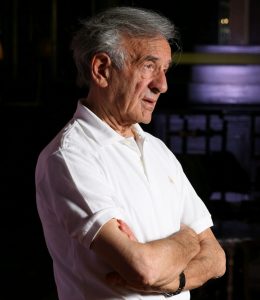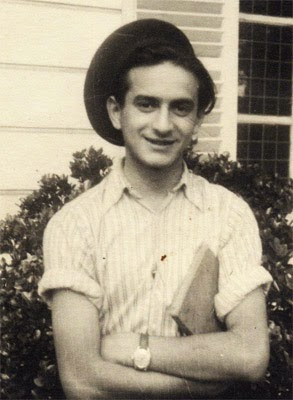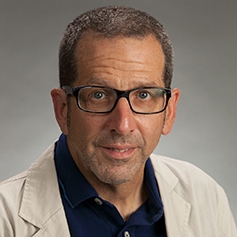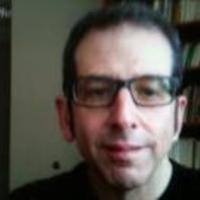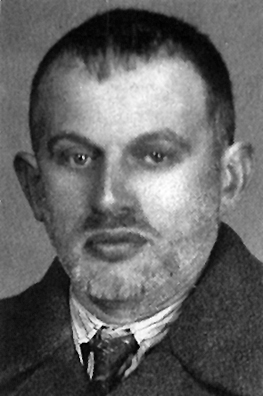Blog
“Elie Wiesel Cons the World” makes our final call on Elie’s tattoo
Written on October 2, 2021 at 6:36 pm, by Carolyn
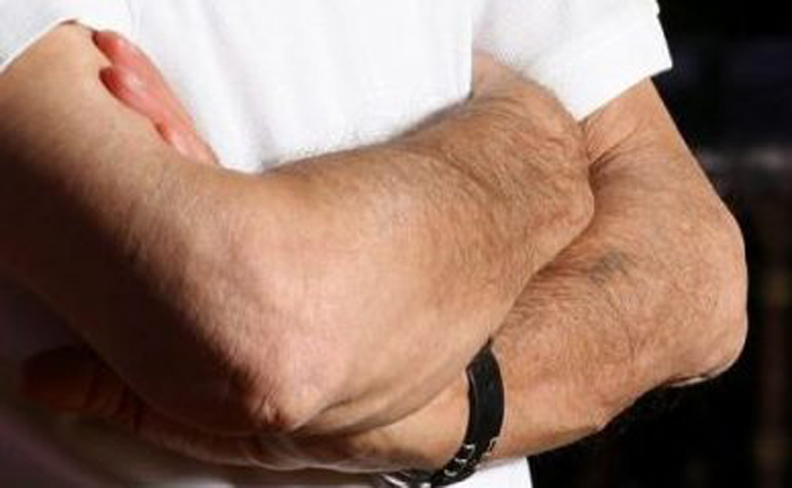
Close-up of Wiesel’s arms from the photograph taken in 2006 by Eyal Toueg, published after Elie Wiesel’s death.
By Carolyn Yeager
It’s been five years now since Elie Wiesel died and his body was buried in a plain pine coffin.
This website premiered in July 2010 with the question: “Where’s the tattoo?” No one had ever seen it, yet Wiesel claimed to have it as proof he was an inmate at Auschwitz in 1944. Please refer to “Where is Elie’s tattoo?” before you read further.
In seven years, this site had learned and published a great deal [over 130 articles] about Elie Wiesel’s life events and the incredible trail of lies he left in his wake. But we had still not seen the tattoo! That is, until the above photo was published by Haaretz, a leading Israeli newspaper, a week after his death. Behold! the distinctive appearance of a bluish smudge on ElieWiesel’s bare left forearm. The photo, said to be taken in Israel in 2006 by Eyal Toueg, is high-resolution and gives every appearance of being an authentic representation of Wiesel at that time—in other words, not photo-shopped. Haaretz is a generally reliable source with a reputation to protect. Since then, I’ve seen no further mention of the photograph.
My takeaway on what we see there is that it is clearly NOT the number A-7713, which is what Wiesel claimed all his adult life he had. He lied—and got away with it. Please see my articles “How Wiesel’s ‘tattoo’ looks from where I’m sitting” and “New (old) pictures come to light in wake of Elie Wiesel’s death” for my impressions in 2016.
Five years later I can say with confidence that whatever it was that may have been on his arm and appears to have possibly been removed was never the number A-7713. (Why? Because it it were A-7713, it would not have been removed while he was still claiming it was there.)
“Appears to have been” is the key here because we’re dealing solely with appearances. We have no statements from Wiesel’s intimates and allies about the tattoo. When it comes to questions about that, they are mute. We also have other images of Wiesel’s bare arm with nothing appearing there or with what could be a faint trace of a number (see below). However, no matter how much these “faint traces” are enlarged, no number can be made out—it is seen to be only a ‘shadow’ on the arm.
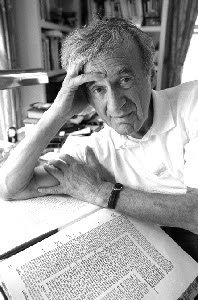
This photo taken on the same day as the one above in 2006. Wiesel is wearing the same shirt and his wristwatch is facing down. But the faint mark on his arm doesn’t match the image above.
The explanation for these last two photos, one taken in 1945 and the other on the same day in 2006 he was wearing the white knit shirt, is that they were both uploaded to the Internet by Loupi Smith and no one else! Neither of these images are found in the U.S. Holocaust Memorial Museum collection, the Auschwitz-Birkenau Museum, or even at Yad Vashem. If they were proof that Elie had a tattoo, wouldn’t they be there?
Loupi Smith is a notorious French Jew who’s long been engaged in battle with revisionists (known as negationists in France), most especially with the honorable Vincent Reynouard. It’s most likely that Smith took images of Wiesel without any mark on the arm and applied the desired effect directly to the photographic print he had obtained. He then uploaded these to the Internet and waited for them to be found, or had friends/agents who “found” them.
As to why Haaretz decided to publish this photo right after Wiesel’s death, Haaretz will have to answer that. We are not mind-readers and have to depend largely on honesty from the parties involved, but honesty has never been forthcoming from Holocaust advocates. For example, see my articles about AP reporter Verena Dobnik who in Nov. 2012 wrote that Wiesel showed her his Auschwitz tattoo by “pulling back his left jacket sleeve” during an interview she was conducting with him. Of course, she didn’t and never would say what it was, just that it was an “Auschwitz tattoo.” See “AP reporter doesn’t reply to questions about seeing tattoo on Elie Wiesel’s arm” and “AP stonewalling legitimate questions about reporter seeing Elie Wiesel’s tattoo.” Nothing unusual here, though—it’s the usual behavior from all media and government sources when it comes to anything “holocaust.”
FINAL CONCLUSION: Elie Wiesel lied about his tattoo. All the feeble explanations/excuses put forward by his supporters and fans for why he refused to show it are inadequate in the face of the proofs we’ve assembled. Wiesel stole the identity of Lazar Wiesel, who was 13 years his senior and who was recorded as being an inmate at Auschwitz-Birkenau (tattooed with A-7713) and at Buchenwald camps in 1944-45. No records for a 16 or 17 year old Eliezer Wiesel born in 1928 exist at either camp.
If he lied about the tattoo, it is certainly believable he lied about being in Auschwitz and Buchenwald. In support of that possibility are the facts that his stories and descriptions don’t match the well-known reality of the camps; his timelines are off; people who were known to be there at the same time he was, even housed in the same buildings, never mentioned seeing him—either before or after he became famous. All this and more is documented at this site.
Elie Wiesel’s “Idea”
Equally important to Elie’s lack of the claimed tattoo is, in my opinion, his admitted twisting of what it means to be a witness. There are two parts to his approach: 1) What happened may not be “true” and what is the “truth” may not have actually happened, and 2) Every Jew should be a witness to the Holocaust regardless of whether they actually participated. Part 2 is made possible by part 1.
Wiesel announced his willingness to deceive in several of his books, and in interviews. Even though he told us exactly what he was doing, it seems no one wanted to take it seriously. The sainthood of Elie Wiesel was too appealing.
 Of his several statements, covered in my article “Elie admits his true stories never happened,” I think the most compelling was in a 1970 interview with Gilles Laponge, published in the book Elie Wiesel: Conversations (2002). You can find the interview online HERE at Google Books. Wiesel said:
Of his several statements, covered in my article “Elie admits his true stories never happened,” I think the most compelling was in a 1970 interview with Gilles Laponge, published in the book Elie Wiesel: Conversations (2002). You can find the interview online HERE at Google Books. Wiesel said:
In [my] book “One Generation After” there is a sentence which perhaps explains my idea: “Certain events happen, but they are not true. Others, on the other hand, are, but they never happen.” So! I undergo certain events and, starting from my experience, I describe incidents which may or may not have happened, but which are true. I do believe that it is very important that there be witnesses always and everywhere.
[…]
The people of my generation are, in various ways, all survivors. We must prevent the Holocaust from being erased from the memory of the world.
He’s telling us he’s writing fiction “based on his experience” but insisting it’s ‘true’, and even 100% true. What is the basis of his experience? Being a Jew. A Zionist Jew. Wiesel’s life history of being a Hasidic Jew is primary in his experience, according to his own words. This means he accepts the following and has said so:
- Belief taking precedence over Reality;
- Religion over History;
- Storytelling over fact-finding;
- Hearsay over first-person evidence; and
- Feelings over Justice.
In other words, it’s Ashkenazi Jewish mysticism vs European Christian Law. It’s interesting to note that at Boston University, where Wiesel had a cushy “professorship” for many years, he taught in the Religion and Philosophy Departments, not the History Department. See my article on BU here.
A little further in the interview Wiesel continues with the cloudy language:
“I believe in a way we are all culpable even though the guilt of the torturer is not that of the witness or the survivor. Do not see in my words the least resignation to evil. […] No, evil is absurd the same way the Holocaust is absurd. I remain convinced that this event, the most significant in history, might very well not have happened.”
Everyone can be a survivor, with the important job of preventing the memory of the Holocaust from being lost or “erased.” For this purpose, apparently everything and anything goes. Making things up to be far worse than they actually were is nothing unusual. It’s considered necessary to reinforce the memory.
When Wiesel claims that “every word” in Night “is true,” he’s using a definition of “truth” different from the standard dictionary meaning. When testifying in a court of law, the lawyers and judges should first establish what is his understanding of truth, but they never have.
On this basis, Wiesel received award after award from prestigious Gentile groups, all the way up to the Nobel Peace Prize. Wiesel has indeed conned the world.
We pronounce Elie Wiesel a false witness from beginning to end.
Romania caves to Elie Wiesel Institute—authorizes holohoax propaganda center
Written on October 10, 2019 at 11:26 am, by Carolyn
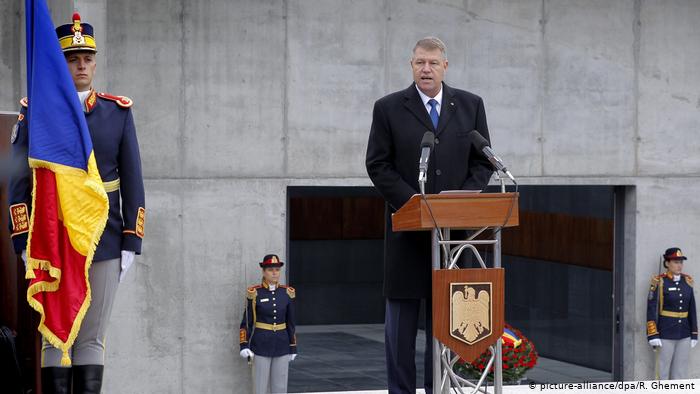
Romanian President Klaus Iohannis announced on Tuesday in Bucharest his approval for the creation of an official Romanian Holocaust Center under the auspices of the Elie Wiesel Institute for Study of the Holocaust.
By Carolyn Yeager
President Klaus Iohannis announced on Tuesday (Oct. 8) his official approval for the creation of the country’s first Holocaust museum in Bucharest, Romania’s capital. He said in a ceremony attended by ‘holocaust survivors’:
“The history of Jewish Romanians, their contribution to the country’s development and the tragedy experienced during the war… represent a legacy which was hidden from us for decades.”
He added: “This museum will not so much bring answers as raise more questions.” He said the goal was to recover the memory of the Holocaust [or maybe to invent it where necessary?]; strengthen the education about the Holocaust, and combat anti-Semitism [oh yes, that too – the actual main goal]. The museum will take up space in a WWII era eight-story building in central Bucharest.
Elie Wiesel behind the museum plan
The new museum will be coordinated by the Elie Wiesel Institute for the Study of the Holocaust in Romania, a “think tank” created by Wiesel and his handlers in 2005. Wiesel claims to have been born in Sighet, Hungary in 1928, which is now part of Romania. In 2004 an international panel led by Elie Wiesel estimated that between 280,000 and 380,000 Romanian and Ukrainian Jews perished from territories under Romanian administration from a total of 750,000. It also found 11,000 Roma were killed. For reliability of Elie Wiesel Institute facts and figures, see “Elie Wiesel Institute Wrong on Romanian Grave Claims.” Also, previous story here.
Elie Wiesel died in 2016.
Only 3,200 (admitted) Jews still live in Romania, according to the last census in 2011; other sources say 8,000 to 10,000. [Jews moved to New York where the living is better. Thousands of others changed their identity to Christian and remain in Romania officially undetected.]
Romania switched sides in the world war in 1944. The government was originally strongly allied with the victorious Germany, but when the tide turned, the Romanian army deserted and opportunistically, with all their German weapons and gear, went over to the Allies. Romania was therefore under Soviet communist control for the next 45 years, remaining a backward, dreary and corrupt country. That was in large part what drove so many Jews to leave. They want communism for Gentiles, but not for themselves.
Elie Wiesel’s sex abuse comes back to haunt his legacy
Written on October 24, 2017 at 5:13 pm, by Carolyn
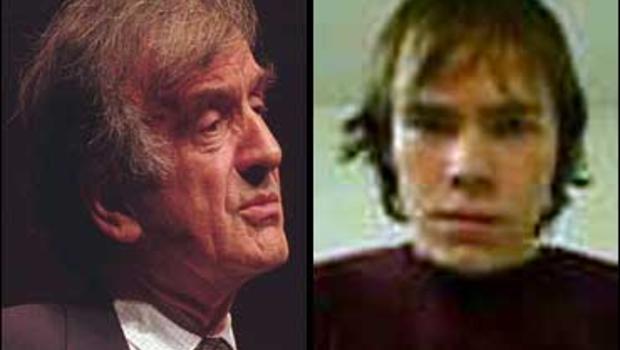
Elie Wiesel (left) at the trial of Eric Hunt (right) was quite prepared to put the 22-year old away for life for frightening him by taking hold of his arm in an empty hotel hallway in 2007. Is it surprising that someone who’s been through the “worst there is” should still be so frightened of a kid?
Which is worse: Grabbing a man’s arm or grabbing a woman’s ass?
By Carolyn Yeager
Attack ‘victim’ Elie Wiesel attacks 19 year old girl and runs away
Elie Wiesel has been accused by a Jewish mother of four, married, a Ph.D from New York University of having squeezed her buttock when she was a vulnerable 19-year-old attending a Jewish charity dinner with her boyfriend’s family. Wiesel, of course, died last year and it’s doubtful his family will comment on the charge.
What it brings to mind for me is this: Elie Wiesel fully cooperated in the prosecution of a 22 year old male, the at-the-time completely unknown Eric Hunt, for grabbing his arm in a hotel elevator in 2007. And now it comes out that Wiesel is also a perpetrator: guilty of surreptitiously grabbing a young woman’s buttocks at a Jewish charity dinner in 1989.
In 1989, Wiesel was 61 years old and it had been only three years since he won the Nobel Prize for Peace in Oslo. He was at the height of his fame.
I believed Jenny Listman’s story right away because radio personality Deanna Spingola had told me of her experience meeting Elie Wiesel after a speech he gave as a “Holocaust survivor.” I do not recall where or when this took place, but Deanna claims she went up, along with other audience members, to meet the famous survivor after his speech. As I remember her telling it, he fixed his gaze on her with suddenly aroused interest, and whatever physical contact took place, whether handshake or something more, he held on to her longer than she felt was appropriate. He also engaged in chatty conversation, asking her about herself. Deanna, at the time an attractive single working woman, blonde and blue eyed, felt the unmistakable sexual vibes emanating from Mr. Wiesel toward her. I suppose if she had told him where she would be after the event (in the hotel bar for instance) he would have found a way to show up there. The impression Deanna had then, at a time she was still a believer in the holocaust narrative, never changed: that he’s a womanizer.
I never doubted Deanna’s account; I hope she will come forward and describe this experience in her own words, for the record. I am not the only person she told this to.
Now, hearing Jenny Listman’s story is confirmation for me that Wiesel was just another run-of-the-mill sexual predator from New York City, a breeding ground of such types.
Listman, describing herself as a non-observant Jew, writes about what happened to her in exquisite detail on her own blog page dated Oct. 19, 2017, as part of the #metoo Twitter campaign following the accusations against Hollywood producer Harvey Weinstein. She defines herself as a PhD, married mother of 4, New Yorker; data science, data visualization specialist. She begins her long post with a quote from Elie Wiesel’s Nobel Peace Prize acceptance speech in 1986:
“I swore never to be silent whenever and wherever human beings endure suffering and humiliation. We must always take sides. Neutrality helps the oppressor, never the victim. Silence encourages the tormentor, never the tormented.”
Listman explains the event as follows: She was participating in a group photo of her boyfriend’s family with guest speaker Elie Wiesel following a dinner given by the Jewish charity to honor their deceased father and husband. Wiesel suddenly said “Wait,” untangled himself from his place in the center of the group, darted in between Listman and her boyfriend at the far end, and then said, “Ok” to the photographer. Listman felt his hand on her shoulder inch down her back until, at the moment the photographer snapped the picture, Wiesel’s hand “squeezed her right ass cheek” and Wiesel “RAN, disappearing into the crowd of over 1000 people.”
When she told her boyfriend what had just happened, he responded with disbelief. Maybe she was mistaken, he suggested, or imagined it. No, she said, she was sure. But she didn’t push the matter any further. She knew it would just upset everyone. And so did Elie Wiesel know that.
The boyfriend, whom she later married and divorced, confirmed this conversation took place, according to Linley Sanders at Newsweek.
Remember that Wiesel’s speaking fee was $25,000 plus chauffeur-driven limousine to and from. Per talk. He was probably not friends of the man being honored, or his family, but was hired by the charity. (That is where so much of your charity money goes – something to keep in mind.) This explains why he was looking to entertain himself while doing a boring job for pay.
Reaction to this revelation
Reaction from the Jews is to downplay, disbelieve or deny. Non-Jews are staying away from the whole story – too hot to handle. They might say the wrong thing and never recover from it.
Commentary, a Jewish publication ran a dismissive article by Daniella Greenbaum the next day, Oct. 20, in which Greenbaum said she didn’t believe Listman’s account, and made her out to be mentally unstable.
The Forward Jewish news organization ran Listman’s accusations when they appeared, but then published a sort of apology/retraction two days later, saying the story “did not meet our journalistic standards and has been removed.”
The far-left Salon website posted the story, concluding that (in my words) there are not just ‘holocaust survivors,’ but there are ‘sex abuse survivors’ too, and we must listen to all of them and sort it out as best we can.
The best coverage of all is what you find right here on Elie Wiesel Cons The World.
Elie Wiesel condemns others but cannot admit his own human failings
To return to Wiesel and Eric Hunt, I think it is the most important moral of the story. Wiesel for many, many years accepted being portrayed as a paragon of blameless virtue and, in turn, portrayed all “holocaust survivors” as blameless victims of totally evil Germans. He was a proponent of the Jewish idea of “Never Forgive, Never Forget” and his infamous sentiment, “Every Jew must set aside in his heart a special place of hate for the German and what the German represents.”
When young Eric Hunt tugged on his arm in a San Francisco hotel demanding to speak to him privately, then let go, turned and walked away when Wiesel began yelling for help, Wiesel called the police and was okay with having Hunt charged with attempted kidnapping, false imprisonment, elder abuse, stalking, battery and the commission of a hate crime – which would have confined the youth to prison for possibly the rest of his life. Wiesel said he was very frightened, which was clearly an unforgivable thing to do to him.
Wiesel then testified at Hunt’s trial, during which he lied under oath about his purported Auschwitz tattoo and his book Night–no big deal to the blithe and breezy icon who can ‘run away’ from his own unlawful actions. Luckily for Hunt, his age and prior clean record allowed the counts against him to be cut to misdemeanor battery and misdemeanor elder abuse to which he had to plead guilty in order to be let off with time served and probation. A Man of Compassion, Wiesel is not.
How will the Wiesel admirers react to their icon’s sexual abuse of a teenager? Will there be more “#metoo’s” showing up in the near future? I’m sure there are more, but whether they have the will or desire to speak out is uncertain, especially as the majority are probably Jewish. I believe the Jewish power structure will crack down hard on any and all disloyalists. But we will keep watching and reporting it if more develops in this fascinating and unexpected saga.
My work on “Night” is featured in a talk given by Jewish Professor Alan Astro at St. Francis College in 2014
Written on June 11, 2017 at 7:19 pm, by Carolyn
By Carolyn Yeager
I happened upon this video and recognized my own text of Yiddish-to-French-to-English translation being used by this professor at a Catholic university in San Antonio TX. Though a native of Brooklyn, Alan Astro says he has been at Trinity University for over 25 years. His field is modern languages and literatures; one of the subjects he teaches is Yiddish culture.
His lecture, titled “Christianity and the Holocaust in Elie Wiesel’s Night” was filmed by St. Francis College and at the 6min59sec mark, he shows text from my very important 2012 article “Night #1 and Night #2—What Changes were Made and Why, Part One.” So you never know who is reading this site – a lot of people and all people who have a professional interest in Elie Wiesel.
At 6:59, Astro shows text translated by Kladderadatsch for this web site, which he calls “Where’s the tatoo?” (sic). He says that even though Yiddish was not known very well even in the Jewish world … “Holocaust deniers somehow get their hands on the Yiddish and manage to get it translated. Here is one holocaust denier or minimizer on the web who makes a whole big deal about the fact that in the Yiddish and French and English original translations Wiesel “is not quite 15” when he is arrested and sent to Auschwitz, whereas he is 15 in the newest edition and this is considered to be something that somehow questions the veracity of the whole historical knowledge of the Holocaust. But that’s another issue all together. But it does show you that things can very often have strange consequences.” (He goes quickly to something else at 8:10. So Astro has my text on the screen for one minute, 11 seconds, enough time to read it all.
This is the segment he used:
3. Not yet fifteen … or fifteen?
UdV Page 63 : Yingl, vi alt bistu? fregt mir a heftling. Zeyn pnym iz geven in der fintster, ober zeyn kol iz geven a mids, a varems. Nokh nisht keyn 15 yor, hob ikh geentfert.
“Kid, how old are you?” a prisoner asked me. His face was in darkness, but his voice was tired and warm. “Not yet 15 years,” I answered.
LN Page 54: Hé, le gosse, quel âge as-tu? C’était un détenu qui m’interrogeait. Je ne voyais pas son visage, mais sa voix était lasse et chaude. “Pas encore quinze ans.” / Not yet 15 years.
SR Page 39: “Here, kid, how old are you?” It was one of the prisoners who asked me this. I could not see his face, but his voice was tense and weary. “I’m not quite fifteen yet.”
MW Page 30: “Hey, kid, how old are you?” The man interrogating me was an inmate. I could not see his face, but his voice was weary and warm. “Fifteen”
This very important passage was discussed above. I think the reader would agree that “not yet 15″ can mean even farther from the age of 15 than “not quite fifteen.” What is clear is that Marion Wiesel has changed the author’s original words to fit them to her husband’s age in Spring 1944.
Astro dismisses this important observation with the misrepresentation (in boldface above) that the example is intended to negate the entire holocaust story. No, it isn’t; obviously it questions the veracity of Elie Wiesel’s truthfulness in “Night” since this scene took place in April or May, and the real Wiesel’s 16th birthday was coming up on September 28, 1944. Thus Wiesel was not 14 in Spring ’44, but had already been 15 for at least 7 months. Astro is not interested in telling that to his audience or pursuing it himself. He is a professor of languages and literature, but not an expert on Elie Wiesel or the Holocaust. Far, far from it.
At 19:33, hear him pronounce Wiesel’s name as weasel (as I say it) and then quickly correct himself to the affectation Wie-zell that he used throughout the talk. This indicates that ‘weasel’ is his default way of pronouncing the name, or the way he first learned it.
At right is another photo of Professor Astro I found online that gives what might be a truer look at the man.
One fact proves more than any other that “Night” is a work of fiction
Written on June 9, 2017 at 10:35 am, by Carolyn
By Carolyn Yeager
Elie Wiesel wrote two ‘official’ accounts of his 1944-45 concentration camp experience: his novel Night (1958) and his official autobiography (Part One), All Rivers Run to the Sea (1995). Thirty-seven years separate these two publications.
Three articles written by me in 2011 (and here) and 2012 contain information that demonstrate conclusively that Night is not a true account of the experience Wiesel may have had with his family at Auschwitz-Birkenau in 1944. Night is written for “effect” and to be a gripping father-son drama that rises to the standards of a literary work of art. Night cannot, therefore, be called Wiesel’s testimony – a claim he made on several occasions.
Because a lot of information was conveyed in these three articles – a lot of details were covered, and I had other purposes in mind – this crucial fact easily gets lost to the reader’s attention. In this article I will zero in on this “crucial evidence” in order to make it crystal clear why Night can only be considered a work of fiction and Elie’s autobiography “All Rivers …” is the place to go for Elie’s ‘true’ account of his experience.
The main evidence I want to put up front is the agreed upon birth date of Elie’s grandmother Nisel Bash Wiesel, mother of Shlomo and Mendel and four daughters. In 1957, Yaakov Fishkovitz filled out a Yad Vashem Page of Testimony (PoT) for his aunt Nisel, stating she was born in 1881 in Chust, Romania and died at Auschwitz in 1944. In 1999, Eliezer Shlomovitz, living in Los Angeles CA at the time, also filled out a PoT for Yad Vashem giving his grandmother’s birth year as 1880, with a question mark. Elie Wiesel never filled out a form for his grandmother, whom he wrote he was very close to, nor for his mother or sister, but only one for his father.
Why Grandma Nisel’s birth date is so important
A birth date of 1880-81 makes Grandmother Nisel 63 or 64 years old in 1944, a figure agreed upon by Hilda Wiesel. However, the story line in Night, accepted as factual by writers, journalists and Internet sources like Wikipedia, gives Father’s age as 50 in 1944, which, if true, would mean grandmother Nisel was only 13 or 14 years old when she gave birth to Shlomo, her third child, and only 11 or 12 at most when she gave birth to her first child. Such a shockingly young age is not in the tradition of Hasidic Judaism to which the Wiesels’ belonged.
In the scene in Night when the family arrives at Birkenau around midnight, Father tells a fellow prisoner who questions him that he is 50 years old and the prisoner urges him to say he is younger. Similarly Eliezer says he is “not quite 15” and is told to make himself older. He subsequently answers “eighteen” when questioned by the guard (or Mengele?). Both men are passed on through. From this, and apparently this alone, the default birth date for Shlomo Wiesel became 1894 and no one, including Elie, ever questioned or corrected that. However, Elie slyly left blank the date of birth on the Yad Vashem PoT he filled out for his father in 2004, and he never offered a birth date for either of his parents.
Wiesel adds 10 years to Father-son age difference in Night
In 1957, Yaakov Fishkovitz also filled out a Yad Vashem PoT for his cousins Shlomo and Mendel Wiesel, giving their dates of birth as 1903 and 1905 respectively. These are probably correct because it makes their mother Nisel age 22 or 23 when Shlomo, her third child, was born, and age 24-5 when Mendel, her fifth, was born.
So why did Elie, in writing Night, make Father 50 years old instead of his real father’s age of 41? Answer: To make the theme of a role reversal between father and son more dramatic, of course. To deepen the loneliness felt by the boy watching his worn-out father break down under the cold, uncaring death machine perpetrated by the evil German Nazis. To write the most heart-breaking story he could!
For the same reason, his 10-year old sister became seven years old and he even made himself a year younger (14 going on 15 instead of 15 going on 16).
It couldn’t be more clear that his purpose in writing Night was different than his purpose for All Rivers, which attempts to give a record of his early life and actual family history. In fact, while Wiesel writes pretty extensively about his grandmother Nisel, who even accompanied the family to Auschwitz in All Rivers – she doesn’t appear at all in Night. He left her out as extraneous to his tightly-constructed narrative, the purpose of which was not to tell it as it really happened.
Summing up
So when the facts diverge between the two books, as they often do, go with All Rivers as the more accurate version. For example, in Night, Eliezer is in the hospital at Birkenau in January 1945 with an infected foot. In All Rivers, he tells the very same story but it is not his foot at all, but his knee that is operated on! If there is any truth to the story, which can be considered doubtful, accept that it was his knee. (I think Elie, or one of his Night editors, liked the dramatic image of leaving a trail of red blood in the snow, so what the heck, just change knee to foot!)
To sum up, Wiesel’s willingness to change important details about his family, and his own major experiences, tells us that creating a “true account” of their year of internment was not his goal. For him, no different from most survivors who write memoirs, he preferred what was “true in his mind.” Or, in other words, what made for a better and hopefully more successful book.

